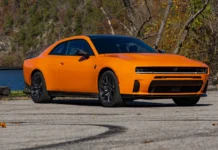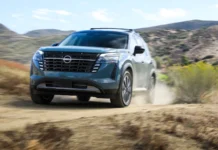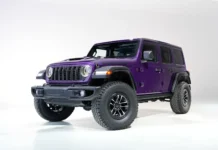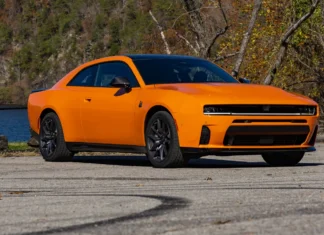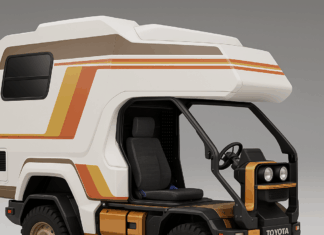
In a market full of car-based crossovers, the Dodge Durango is unapologetically an SUV.
The big SUV shares its running gear and chassis with the Jeep Grand Cherokee, albeit with a longer wheelbase to support three-row seating. That means the engine is mounted longitudinally with the transmission behind the engine, sending power to either the rear wheels or to all wheels, depending on if it was equipped with all wheel drive.
The 2015 Dodge Durango Citadel tested here is the top-of-the-line, all-wheel-drive model. Starting at $43,595 and with an as-tested price of $49,875, it costs a lot, but it gives a lot in return.
|
2015 Dodge Durango Citadel AWD |
||||
|---|---|---|---|---|
| Engine | Total System Power | Torque | Transmission | As-Tested Price |
| 3.6-liter V-6 | 290 hp @ 6,400 rpm | 260 lb-ft @ 4,800 rpm | 8-speed automatic | $49,875 |
Outside, the Durango’s styling is clearly from the Charger school of design. The big Dodge crosshair grille and headlights get their inspiration from the previous generation Charger and the Durango also shares its coke-bottle fender arches. It’s a big, beefy design that does its best to make the Durango look less of a minivan than some of its crossover competition.
The Durango’s interior continues the trend of attractive Fiat-Chrysler designs. The same spongy material used on the Charger’s dash is present here, but it’s better finished than in the Charger, with tighter gaps. The interior is simple, stylish and elegant. Nothing is out of place and nothing was put in just for the sake of style.
Seats are comfortable if a little large – smaller drivers will slide around between the side bolsters – with a broad range of motion that makes it easy to find a comfortable seating position. Second-row seats are nearly identical to the fronts, with the test car having an optional center console complete with additional USB ports. In the back, the seats are small, but there’s still enough room back there that they’re not just for small children. A 5 foot, 10 inch passenger fit back there with decent legroom. It would be uncomfortable for a long trip, but fine for a short in-town drive.

The gauges are similar to other Fiat-Chrysler products, with bespoke tachometer, fuel and temperature gauges flanking a 7-inch customizable screen. The screen can show either a simulated analog dial or a digital readout for speed and has an array of informational screens that can be changed with steering wheel controls.
The center stack is dominated by the 8.4-inch Uconnect touchscreen. The Uconnect system, with its logical, intuitive layout and simple redundant buttons and knobs, continues to be one of the best infotainment systems in the industry. However, like the Jeep Cherokee and Dodge Charger tested earlier at TFLcar, it suffers from the infuriating inability to turn off the audio. All Uconnect-equipped cars will lose points for that until Fiat-Chrysler finally fixes it. It’s a simple fix and will easily solve the only real problem with the otherwise excellent system.
The overall simplicity of the Durango’s controls is refreshing. There’s a simple rotary shift knob – which, although easy to use, is somehow not as satisfying to use as a shift lever – and that’s it. No knobs or buttons for things like sport mode or for a thousand different settings for the all wheel drive system. Just four choices to be made – P, R, N or D. If all wheel drive is needed, it’ll just kick in. No buttons to press. Especially after experiencing the interior of the Lexus ES hybrid, the Durango is wonderful in its simplicity.

Under the hood is the same 3.6-liter Pentastar V-6 as in the Charger. In the Durango, it makes 290 horsepower and 260 lb-ft of torque. It pulls the mighty – and mighty big – SUV with authority. It may not be the neck-snapping torque of a Hemi V-8, but it’s more than enough power for most Durango buyers. The eight-speed automatic transmission shifts cleanly, but like most transmissions with that many gears, it’s programmed for efficiency over power. It’s not uncommon to see sixth gear on a 35-mph street. When power is needed, though, the tranny downshifts quickly.
Despite the eight-speed’s propensity toward economy, the Durango is still a big, heavy all-wheel-drive vehicle. The EPA rates it at 17 mpg city, 24 mpg highway and 19 mpg combined. During the test week, the Durango managed 18.2 mpg in predominantly in-town driving.
The Durango’s ride is plush without being too floaty. It’s not a sports car and the steering rack is a little slow, but it’s perfectly acceptable for a big SUV. The Durango is a very satisfying vehicle to drive. It’s quiet, comfortable, and it can haul when it has to. It’s a very easy car to live with day-to-day.
Space behind the third-row seat is usable if meager, but those seats are simple to fold down to give plenty of cargo space. The middle-row seats can also be folded down for a minivan-like capacity. Dodge deserves bonus points for headrests that automatically fold down and out of the way when the seats are folded.

Since the Durango is closely related to the Grand Cherokee, they are complementary competitors. If a buyer likes the Durango but doesn’t need the third row seats, they can go get a Grand Cherokee, and vice-versa. The Durango’s chief competitors are the large crossovers like the GM offerings (GMC Acadia, Chevrolet Traverse and Buick Enclave) and the Ford Explorer. All models are similar in size, power, fuel economy and price, but what the Durango has going for it is that it’s an honest-to-goodness SUV. It’s not a passenger-car-based tall wagon like the GM or Ford offerings, and that gives it an edge over its competition, or at least something unique.
At nearly 50 grand, the Citadel-trimmed test car is a little pricey, although the top-of-the-line GM models are similarly priced and the Platinum-level Explorer is pricier still. That price, though, brings with it a lot of useful options like dual flip-up LCD screens on the seatbacks with a Blu-Ray player, wireless headphones and a remote control, and of course the premium leather heated and cooled seats. There are more frugal ways to spec out a Durango, but those that opt for the fully loaded version shouldn’t feel like they got a raw deal.
- Buy It,
- Lease It,
- Rent It,
- or Forget It,
The 2015 Dodge Durango Citadel AWD gets a Buy It!
Despite losing points for the Uconnect’s missing audio-off button, the Durango is a fine large SUV that is a joy to live with every day. The fact that it’s a real SUV and not a wannabe crossover is just icing on the cake.
How we’d build it
To get the maximum value for the money out of the Durango, start with the SXT Plus model in all wheel drive, which starts at $35,095. Add the Popular Equipment Package for $1,095, which adds a backup camera, Bluetooth audio streaming and heated front seats. And for some extra style, add in the Rallye package, which for $1,995 comes with a sinister blacked-out appearance group complete with black painted alloys and leather suede seats. All tolled, the price is $38,180, more than $10,000 less than the test car but with plenty of style and equipment.
Check out this TFLcar video of the Hemi-powered 2014 Dodge Durango R/T:


















